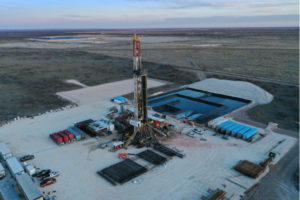In Texas, well known for its oil industry, drillers are facing a new difficulty, earthquakes. The tremblors are happening when drillers push their wastewater back into wells in the area near where they are drilling for oil and gas, near the cities of Odessa and Midland. In an effort to reduce the quakes, drillers are being forced to dispose of the water further away, driving up the costs of drilling, and hurting the American oil industry. The Wall Street Journal reports:
Frackers in America’s hottest oil field are facing an expensive new setback: earthquakes.
Shale companies in West Texas will have to pay more to move millions of barrels of wastewater that surfaces from oil wells and can aggravate tectonic fault lines when deposited underground. A recent spate of earthquakes prompted state regulators to stop companies from pumping as much water underground, forcing some drillers to move water farther afield.
Most of the earthquakes have been relatively mild so far and have caused limited property damage. The rising number of earthquakes has led the Texas Railroad Commission, which regulates the oil industry, to shut or sharply reduce the capacity of scores of so-called disposal wells to protect nearby communities.
The wells are used by large oil companies including Chevron Corp. CVX 1.70% , ConocoPhillips COP 3.73% and Coterra Energy Inc. CTRA 1.65% to inject wastewater into geologic formations. The limitations have left Permian Basin drillers to find other ways to transport wastewater, including high-cost trucking.
Trucking the water to disposal wells elsewhere is about five times the cost of using pipelines, according to shale executives and analysts. Some companies said they can avoid trucking by sending water through a network of pipelines to regions unaffected by seismic activity. The added expenses come as frackers are already facing higher costs from labor and supplies.
Permian producers’ collective annual cost to jettison that water could increase, conservatively, by more than $200 million if they have to truck it all out, according to market intelligence firm Sourcenergy. If companies are unable to find new means of disposal, they may have to curtail tens of thousands of barrels a day of oil production.
The setback could also limit some producers’ ability to increase output in response to the highest oil prices in years. Many that are forced to truck water elsewhere will likely have to shift drilling rigs away from the areas where the Railroad Commission concentrated its cutbacks, executives said.
“If you’re forced to truck it, it’s going to have a devastating impact on your lease operating expenses,” said Richard Jennings, president of private West Texas oil producer Atlantic Operating II LLC, which says it operates shallow disposal wells unaffected by the restrictions.
In 2020, the latest year for which data is available, oil producers pumped about 342 million barrels of water into the saltwater disposal wells that the Railroad Commission began restricting last fall. The regulator acted after a sharp uptick in earthquakes, including near populated areas like Midland and Odessa.
The number of earthquakes with a magnitude of 3.0 or larger in the Texas portion of the Permian rose to 176 last year, up from 51 in 2020 and nine in 2019, according to Sourcenergy, which analyzed state seismic activity data.
If you’re willing to fight for Main Street America, click here to sign up for the Richardcyoung.com free weekly email.





